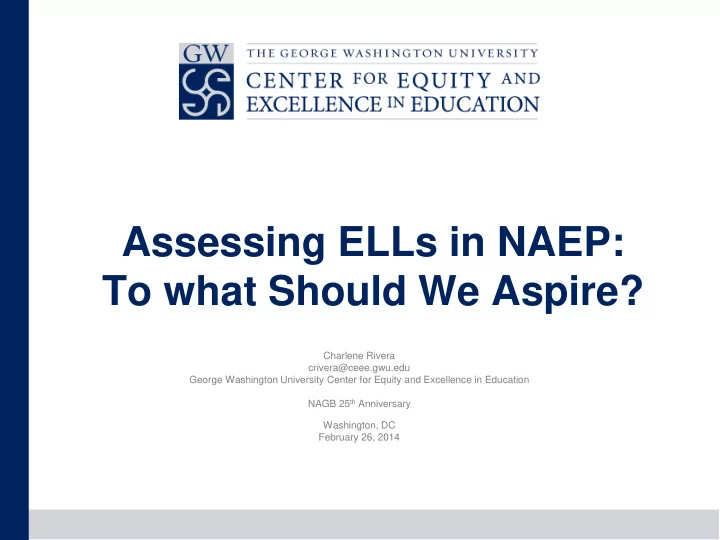

Assessing ELLs in NAEP: To what Should We Aspire? Charlene Rivera crivera@ceee.gwu.edu George Washington University Center for Equity and Excellence in Education NAGB 25 th Anniversary Washington, DC February 26, 2014
Overview Topics Additional Topics Criteria for defining who Distinguishing ELLs from is an ELL SDs Inclusion policy Reporting on ELLs and former ELLs Accommodation policy Considering linguistic access for ELLs in computer based assessments The George Washington University Center for Equity and Excellence in Education http://ceee.gwu.edu 2
ELLs are diverse Foreign Born or U.S. Born Young learners • Level of ELP • making good progress academically • Struggling academically Adolescents Level of ELP/ years in • program (Long-term ELLs) On grade level • academically Struggling academically • With interrupted or limited • formal schooling The George Washington University Center for Equity and Excellence in Education http://ceee.gwu.edu 3
Criteria for Defining Who is an ELL No common operational definition of LEP in NAEP NAEP provides criteria for schools to include ELLs The George Washington University Center for Equity and Excellence in Education http://ceee.gwu.edu 4
Inclusion Policy Changing Inclusion Policy 1964-1990; 1994 1995-1996 1998 2002 2010 INCLUDE without EXCLUDE INCLUDE INCLUDE LEP Maximally accommodation all Students Exclude LEP LEP students if INCLUDE ELLs LEP students with and without student with less instructed for with and without instructed in English accommodations than 3 years of at least 3 years accommodations for 3 or more years; receiving English in English; who have been in INCLUDE without instruction in instruction include if US schools one accommodation English less than or more years school staff third year students; 3 years; Exclude students determine accommodated/ only if they can not inlusion is non- demonstrate their accommodated appropariate knowledge of the samples no subject even with an longer kept accommodation The George Washington University Center for Equity and Excellence in Education http://ceee.gwu.edu 5
Inclusion Policy Benefits improved measurement of overall student achievement enhanced representativeness and generalizability of NAEP results greater fairness and equity Challenges Upholding validity Maintaining reliability Consistent implementation of inclusion policy Preserving the ability to analyze and report trends in the face of changes made to procedures and in the sampled population of respondents The George Washington University Center for Equity and Excellence in Education http://ceee.gwu.edu 6
Inclusion Policy Implementation Inconsistency Large differences in the inclusion rates of LEP students in the NAEP state-by-state comparisons state-by-state comparisons may be differentially affected and the findings not comparable across all states The George Washington University Center for Equity and Excellence in Education http://ceee.gwu.edu 7
Inclusion Policy Implementation Inconsistency Interviews with school-based decision-makers identified factors influencing their decision to accommodate ELLs (1) understandings of ELL eligibility for accommodation (2) nature of linguistic accommodations, (3) use of NAEP guidelines and guidance The George Washington University Center for Equity and Excellence in Education http://ceee.gwu.edu 8
Accommodation Policy Implementation Inconsistency confusion in applying eligibility criteria for accommodations At least half of the decision-makers across all four districts thought that accommodations could only be provided to students with an IEP Other decision-makers who did assign accommodations to ELLs, expressed confusion about the criteria which should be used to match testing accommodations to ELL needs The George Washington University Center for Equity and Excellence in Education http://ceee.gwu.edu 9
Accommodation Policy Addressing the linguistic needs of ELLs NAGB commissioned paper, An analysis of state assessment policies addressing the accommodation of English language learners. 1994 (Rivera and Collum, 1994) The paper documents research on accommodations and recommends use of an ELL responsive accommodation taxonomy. The taxonomy links the use of accommodations to the needs of ELLs and incorporates research on second language acquisition. The George Washington University Center for Equity and Excellence in Education http://ceee.gwu.edu 10
Accommodation Policy Assignment of Accommodations Inconsistent use of teacher judgment to assign accommodations was no better than random assignment of accommodations to students Students assigned accommodations based on individual needs, performed significantly better than their peers on the mathematics test. Students inappropriately assigned accommodations did no better than students without accommodations (Koran and Kopriva, 2006) The George Washington University Center for Equity and Excellence in Education http://ceee.gwu.edu 11
To What Should We Aspire? Implementing valid/reliable assessments Recognizing the diversity of ELLs Consistently including ELLs Providing ELLs with linguistic access to assessments Differentiating accommodations for ELLs at different levels of ELP Monitoring implementation of criteria for including ELLs The George Washington University Center for Equity and Excellence in Education http://ceee.gwu.edu 12
To What Should we Aspire? Using student background variables to inform selection of appropriate accommodations based on a consistent operational definition of English language learner, student’s level of English language proficiency, and the language of instruction Using an ELL-responsive framework as a tool for selecting appropriate accommodations for ELLs Using accommodations supported by research The George Washington University Center for Equity and Excellence in Education http://ceee.gwu.edu 13
To What Should we Aspire? Tracking/reporting results for ELLs and former ELLs taking into consideration level of ELP and other background variables The George Washington University Center for Equity and Excellence in Education http://ceee.gwu.edu 14
The George Washington University Center for Equity and Excellence in Education http://ceee.gwu.edu 15
Thank you! Charlene Rivera crivera@ceee.gwu.edu 16 The George Washington University Center for Equity and Excellence in Education http://ceee.gwu.edu 16
Recommend
More recommend